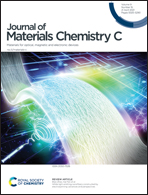Deterministically assigned directional sensing of a nanoscale crack based pressure sensor by anisotropic Poisson ratios of the substrate†
Abstract
Despite recent developments in mechanosensors for biomedical applications, detection of broad ranges of mechanical signals with high sensitivity is still challenging. While crack based mechanosensors have shown huge potential in biomedical application because of their extraordinary sensitivity, there has been a structural limitation in that the high sensitivity has only been possible by in-plane strain with a specific directionality. Here, we demonstrate an advanced strategy to achieve enhanced sensitivity and signal linearity of the crack based pressure sensor by employing an anisotropic Poisson's ratio substrate (APS). The direction-specific pressure responsiveness can be assigned anisotropically by the sandwich structures of two honeycomb layers with distinctive moduli. Structural optimization of APS results in anisotropic Poisson's ratios of 0.67 and 0.11 in υzx and υzy, respectively, which allow a high sensitivity with 3.1 × 106 MPa−1 between 0 and 3 MPa with remarkable linearity by harnessing vertically applied stress (towards the z-axis) effectively to open lined cracks. As a demonstration, an array of crack based sensors is embedded in a jaw prosthesis for patients who have undergone mandible removal surgery. The embedded sensors evidence that they are capable of spatially resolved sensing in the events of mock biting at the physiological pressure ranges.



 Please wait while we load your content...
Please wait while we load your content...